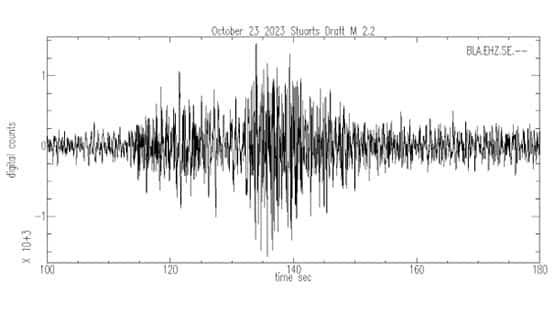
A “much larger earthquake” is possible in Stuarts Draft after a series of three small earthquakes over eight days, according to a Virginia Tech professor.
All three earthquakes in Augusta County measured between 2.2 and 2.4 magnitude with a depth starting on Oct. 15 at 2.4 km; progressing on Oct. 22 at 3.5 km; and 8.5 km on Oct. 23.
“Sometimes a series of small shocks in a small area turn out to be foreshocks for a much larger earthquake,” said Martin C. Chapman, a research professor of geophysics. “But this is by no means always the case. If it were, we would be able to reliably predict damaging earthquakes.
“A series of small shocks in a small area that are not followed by a significantly larger shock is a common occurrence. We call these sequences earthquake swarms, and there are common in the eastern U.S., particularly in the Appalachian region.”
Typically, swarm sequences last less than a month, Chapman said, but they may start back up at some point in the future.
“What we are seeing near Stuarts Draft so far is a typical swarm,” he said. “It may last for weeks, or months, and in a few cases, years. Usually, the earthquakes are quite similar in terms of magnitude, and they are confined to a few miles across.”
Chapman said at the 2.0-2.5 magnitude level, the shaking is usually very brief, only a couple of seconds, and they are frequently reported as being heard as much as felt.
“The sound is caused by seismic P waves being transmitted from the solid ground into the air and traveling in the air as acoustic waves, which we hear typically hear as a boom if close at hand or as hollow, muffled thunder if a few miles away from the epicenter,” Chapman said. “This noise terrifies dogs and cats.”
In the epicentral area, he said, minor damage in the form of objects being displaced indoors, minor cracking of plaster, usually begins at the 4.5 level.
In Augusta County and surrounding areas, there are numerous mapped faults, but most of them, Chapman said, were formed hundreds of millions of years ago and are inactive in the modern stress field.
He said there are some active faults that are currently unmapped. However, modern earthquakes mostly occur on pre-existing faults.
Chapman said he covers earthquakes of this nature in his graduate level course in seismology.
Historically, damaging shocks happen in Virginia once every 50 to 100 years. They have occurred in the Valley-Blue Ridge geologic/physiographic regions of western Virginia (Giles County) and in Central Virginia (Charlottesville to Richmond, centered within 50 km on either side of the James River).
Most Virginia earthquakes have occurred in the New River and James River areas, Chapman said.
“Why that is the case is something that we are trying to figure out.”
The largest historical earthquake in Virginia occurred in 2011 in Mineral in Louisa County. The next largest shock occurred in 1897 near Pearisburg in Giles County.
“Magnitude 5 and bigger earthquakes occur in Virginia on average about once in 75 years,” Chapman said.
As for the current shocks happening in Stuarts Draft, Chapman said, “it is worth paying attention to.”
More information
Virginia Tech Seismological Observatory
U.S. Geological Survey Earthquake Information Center
Related stories
Another day, another earthquake in Virginia; this one deeper than last two
USGS: Second earthquake in one week in Virginia; this one stronger than first
Unknown noise solved: USGS reports 2.2 magnitude earthquake in Virginia
Loud noises heard in southern Augusta County Sunday; cause not found










